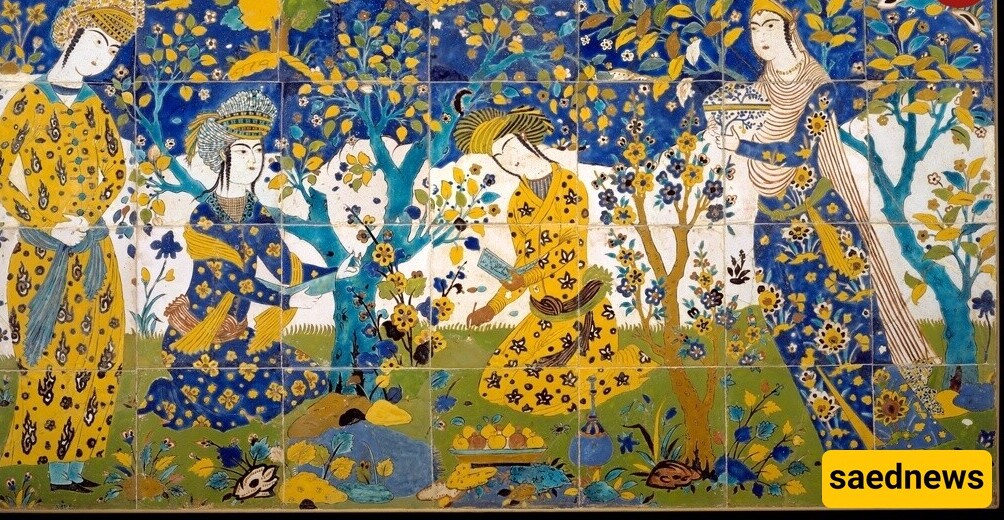SAEDNEWS: The art of the Shah Abbas period is a mesmerizing blend of colors. These colors intertwine in carpets, tiles, and paintings, spiraling through diagonal lines, and like mystical vines, they lift the viewer’s soul to the heavens.

According to SAEDNEWS, Few people throughout history have succeeded in creating a new style in art, and these people have usually been artists, not rulers. However, Shah Abbas the Great, who came to power in Iran at the end of the 16th century, sparked an artistic renaissance at the highest level. His construction projects and his support for new cultural elites led to one of the finest periods in the history of Islamic art.
What Iranian artists added to the tradition of Islamic art during the reign of Shah Abbas was a tendency to depict nature with a delicate and passionate atmosphere, which did not contradict the previous legacy but rather enriched it. In the art of the Shah Abbas period, nature, poetry, color, music, order, emotion, and in short, everything necessary to create the highest level of art, were brought together.

As a small example of this magnificent artistic birth, you can consider a painting by an artist named Habibullah from the manuscript of "Mantiq al-Tayr." In this painting, which depicts the scene of the hoopoe speaking to other birds, the artist has created such a delicate and imaginative atmosphere that it feels as if one can smell the flowers from the stream and hear the sound of the breeze rustling through the tree branches.

During this glorious era, the city of Isfahan was the center of art, politics, and commerce. From 1597 to 1598, Shah Abbas moved the Safavid capital to Isfahan. This move was part of his extensive plan to pull the country out of economic stagnation. To revive the national economy, Shah Abbas invited foreign traders and established trade agreements with several European countries. He increased the production of carpets and textiles in state-run workshops and brought 300 Chinese potters and their families to Iran to take advantage of the intense public interest in Chinese pottery.

He then moved the Armenians of Julfa, who controlled a large part of the international silk trade, to a neighborhood in Isfahan called New Julfa and granted them the monopoly over silk exports. Shah Abbas also created a new standing army that stopped foreign invasions and restored the country's territorial stability.
Shah Abbas strengthened the image of the Safavid state with the architecture of his new capital. He created a two-kilometer-long market from the old center of the city toward the new square (Naqsh-e Jahan) near the Zayandeh River. Four important structures were built around this square: the northern entrance to the market was decorated with paintings of Shah Abbas's victories over the Uzbeks, the Shah Mosque stood to the south, the Sheikh Lotfollah Mosque to the east, and the Ali Qapu Palace, a two-story hall for public meetings, was built to the west. Thus, the four main pillars of the Safavid state—religion, commerce, military, and the royal family—were visually united in a grand statement.

Jean Chardin, a French jeweler who traveled to Iran between 1664-1670 and again from 1671-1677, called Isfahan “the greatest and most beautiful city in the entire East.” He described the city’s population as consisting of Christians, Jews, Zoroastrians, Muslims, and merchants from all over the world. He counted 162 mosques, 48 schools, 1802 caravanserais, 273 public baths, and 12 cemeteries, reflecting the extensive architectural work carried out by Shah Abbas in the city.
Among the notable neighborhoods of the city during that era was the area behind the Ali Qapu Palace, which extended with many gardens up to Chahar Bagh, a long boulevard lined with parks, noble residences, and royal family palaces. The tile works and wall paintings were some of the luxurious decorations of these buildings.

Shah Abbas was also an active patron of painting and book production. His commission for a manuscript of the Shahnameh revived the royal painting workshop, which had diminished during the reigns of the two previous kings.
He also restored the 15th-century Timurid manuscript of "Mantiq al-Tayr," adding four new paintings to it. This manuscript was gifted to the shrine of Sheikh Safi in Ardabil in 1609. During Shah Abbas's reign, artists such as Aqa Reza, Sadeqi Beg, Reza Abbasi, and Mir Emad created works that are now considered some of the most valuable treasures of Islamic and Iranian art.

